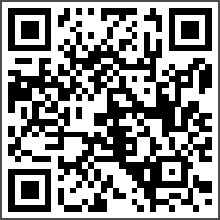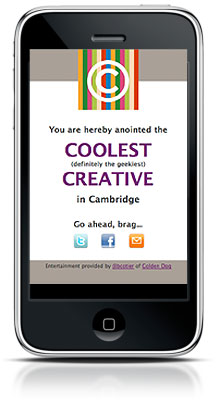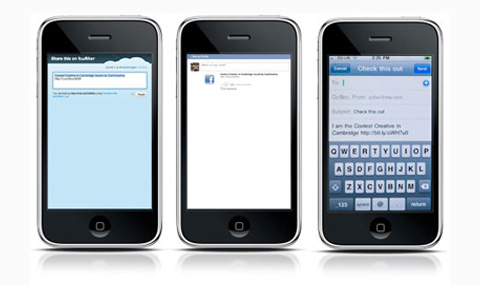I wanted to test to see how easy it would be to change something that is 2-D into an interactive and viral experience. I did an experiment to test 2-D bar code readers on mobile phones at a CamCreative meeting in Cambridge on the 28th of October. The result was a room full of creative people seeing new potential for these stunningly beautiful symbols that have been around since 1994.
 A PowerPoint slide with only this image on a white background was presented to the audience. While everyone was familiar with the symbol there was a bit of confusion as to why one was suddenly dominating the screen. The time had come to test whether in the palm of my hand I had a reader to unlock the code. I raised my iPhone and scanned the image. I turned to see that quite a few others in the room were also reading the image.
A PowerPoint slide with only this image on a white background was presented to the audience. While everyone was familiar with the symbol there was a bit of confusion as to why one was suddenly dominating the screen. The time had come to test whether in the palm of my hand I had a reader to unlock the code. I raised my iPhone and scanned the image. I turned to see that quite a few others in the room were also reading the image.
 My QR reader took me immediately to this web page. I asked the audience, “Please, no sharing, but they could brag.” Heads were bent in concentration as the message was shared via Twitter, Facebook and email. I revealed at the end of the evening to everyone who did not have a reader what the code unlocked.
My QR reader took me immediately to this web page. I asked the audience, “Please, no sharing, but they could brag.” Heads were bent in concentration as the message was shared via Twitter, Facebook and email. I revealed at the end of the evening to everyone who did not have a reader what the code unlocked.
The Bar Code Generator
I tested several online bar code generators. My pick was this free and really easy to use generator by Kaywa. It does require downloading an app to be able to read it.
JagTag is one of the leading developers of 2-D barcodes for mobile solutions, but the software is not free of charge. But using them does not require an app and in early 2010, Jagtag could be read by 87% of the smartphones in the US There are other additional benefits to using JagTag, including custom designs and incorporating brand elements in the bar code.
Mobile App QR Readers
It was easy to find quite a few excellent QR readers available for all makes of smartphone on the market. My choice for my iPhone was the 99¢ QuickMark QR Code Reader By SimpleAct Inc.
The Destination
Testing market penetration of mobile bar code readers was one aspect of my experiment. I also wanted to test the potential of interactivity and sharing capabilities using a mobile device. Having only an afternoon to devote to this experiment I created a simple landing page with three links to encourage sharing the experience.
Each button was coded to launch an application, publish a custom message and track functionality. I used ShareThis API for the Twitter and Facebook buttons. ShareThis requires a free registration to obtain a ShareThis ID. ShareThis can easily be incorporated into your Google analytics. For more details visit the ShareThis site.
Here is the sample code for Twitter:

I color coded places that you will change for your situation. Twitter can be replaced with either Facebook or LinkedIn. For long links I recommend using bity URLs.
This video gives a more detailed explanation:
Here is the result of each of the buttons.

This code works beautifully in any situation that you want to share something other than the current URL. It is brilliant for HTML emails containing multiple links to share not the email but the information.
The Results
Forgive me for not having precise stats. About a quarter of the folks were able to scan the image and share it immediately. One of the attendees demonstrated the incredibly low barrier to entry. While sitting in the audience she downloaded a bar code app. After the presentation during the reveal she was able to scan and read the code. She excitedly shared her experience with her network.
That’s how easy it was for me to change a static PowerPoint slide into an interactive experience that was immediately shared around the world.
This article in the New York Times published this week discusses testing bar code technology in Albany, New York. My purpose for conducting the experiment at CamCreative was to stimulate people to creatively utilize 2-D bar code technology.
The potential for mobile applications using this technology is limited only by your imagination. If this has sparked an idea with you, please share it with us. Your thoughts and comments are appreciated.
9 responses to “The QR Code and Smartphone Experiment”